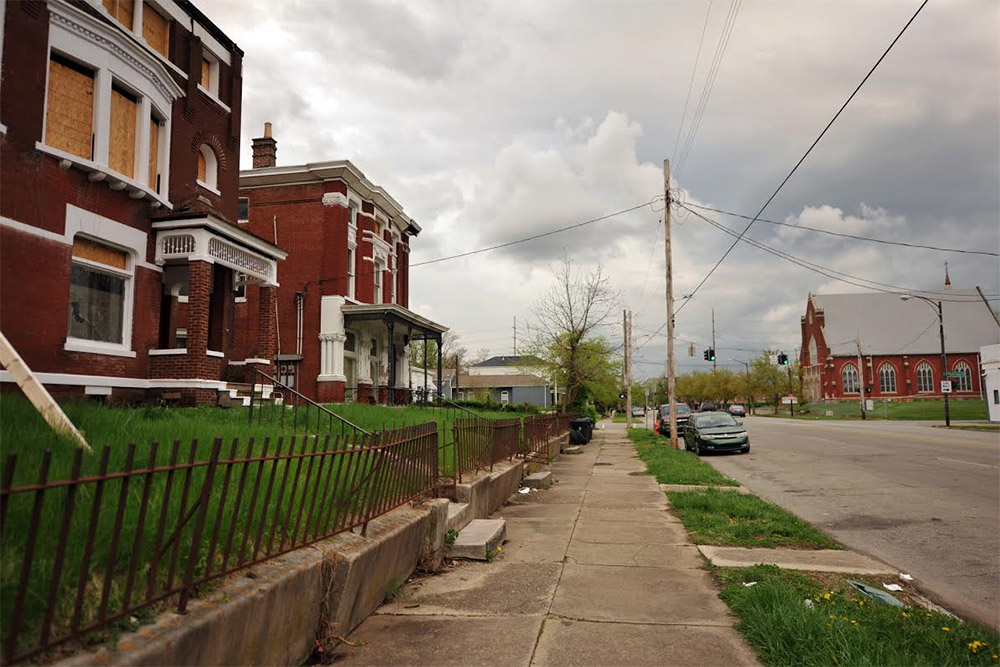Congratulations to Joe for correctly identifying our last sidewalk photo as Muhammad Ali Boulevard looking west from Second Street. On the right-hand-side, you can see the old Odd Fellows Hall, which sits on the site of the proposed Omni Hotel and whose fate is still murky, although it likely will end up being saved in the end. A lot has sure been torn down around here.
Here’s a new sidewalk challenge for this week ready to be identified in the comments below for your chance to win an official Broken Sidewalk magnet. (The rules: First correct response wins; Leave a real email so we can get in touch if you win; No repeat winners for four months; Comments must be left on this news roundup.) Good luck!
And now on with the week’s top #cityreads in the news:
Coyotes moving in, gentrifying New York City. Listen Louisville, you don’t know how good you’ve got it. From the still warm ashes of post-hyper-gentrification comes “Naturification”. Curbed
What does it mean to have an Age-Inclusive City? A terribly interesting issue for rapidly urbanizing areas: How do we design fast moving cities for slower moving residents? Impact Design Hub
Using LEGOs to explain taxes and economic inequality. Making information not only accessible but legible is an important new task for urban designers and planners. In New York City we’re very lucky to have the Center for Urban Pedagogy to help us accomplish this daunting task. But it’s not just NYC; smaller cities like Louisville are realizing the power of making data available to residents in a form where they can use it for social good (see GRIDS work). Information = accessibility + data + legibility. City Lab
The town that creep build. “South of San Francisco, a whole town is being deformed by plate tectonics. These are the slow but relentless landscape effects known as ‘fault creep.’” BLDGBLOG
Ten ways cities can take advantage of the urban manufacturing revival. An interesting report from Distl in Toronto about urban manufacturings “revival.” Some interesting questions around scale and sustainability surface in this conversation. Sustainable Cities Collective
Busting three myths about public housing. Although all the information points us to the truth, public housing still retains its stigma. Is it time for urbanists to “do the reading” instead of relying on the mythology? Next City
Closed in and crowded out: urbanising against the city. Issues around ‘who is the city for?’ continue to resound for the urban problematique. Europe provides an interesting example here. OpenDemocracy
The rise of “Segregated Affluence”. Who we talk about when we talk about segregation can change the conversation to reflect the political and economic causes of this condition. Planetizen
Race may matter more than income when it comes to neighborhood quality. “Aliprantis and Kolliner’s research suggests that if we continue to ignore racial segregation as a factor in neighborhood equality, policies aimed at creating opportunity for low-income Americans will continue to yield disappointing results.” Next City
These American cities are fighting for control over electricity and the internet. An important call to action for Louisville. What happens when the public control their utilities? OpenDemocracy



20th and West Jefferson
Looking west on W. Jefferson Street at Dr. W. J. Hodge Street (S. 21st Street) with the Hughlette Temple Church in the background.
Here’s a highway trivia question for you from that area. What do the 100 of S. 22nd Street and the 300 block of W. Main Street have in common that no other blocks have?
Wait – I got it wrong. Add to the 100 block of S. 22nd and the 300 block of W. Main also the 300 block of W. Market. Sorry for the error.